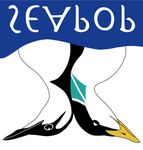Short Report 10-2009 - Seabirds in open sea Per Fauchald & Torkild Tveraa - SEAPOP
←
→
Page content transcription
If your browser does not render page correctly, please read the page content below
SEAPOP Short Report 10‐2009
Adult gannet. (© Eirik Grønningsæter)
Seabirds in open sea
Seabird surveys in 2008
In 2008, we joined the Institute of Marine Research’s regular ecosystem surveys in the Norwegian
and Barents Seas in spring/summer and autumn (Figure 1). Seabird observations in the Norwegian
Sea were conducted from the research vessel G.O. Sars with a total transect length of 2173 km from
13 to 30 May. Seabird observations in the Barents Sea were made as a part of the Ecosystem Barents
Sea Survey from 20 August to 1 October when we joined the research vessels G.O. Sars, Johan Hjort
and Jan Mayen. During this survey, we covered a total transect length of 6552 km. The average
densities of different seabird species observed in similar cruises in 2007 and 2008 are summarized in
Table 1.
Figure 1
Seabird transects in the Norwegian Spring and summer cruises (May)
and Barents Seas 2008. Autumn cruises (August – October)
2SEAPOP Short Report 10‐2009
Table 1 Densities of seabirds (individuals/km2) observed from ecosystem surveys conducted in the
Norwegian Sea (spring/summer) and in the Barents Sea (autumn) in 2007 and 2008.
Spring/summer Autumn
Common name Scientific name
2007 2008 2007 2008
Fulmar Fulmarus glacialis 402.43 83.94 25.02 297.20
Sooty shearwater Puffinus griseus 0 0 0.011 0.005
Shag Phalacrocorax aristotelis 0.003 0.000 0.001 0
Common eider Somateria mollissima 0.026 0.016 0.001 0.009
Long‐tailed duck Clangula hyemalis 0.007 0.000 0 0
Pomarine skua Stercorarius pomarinus 0.061 0.006 0.358 0.231
Arctic skua Stercorarius parasiticus 0.008 0.039 0.044 0.042
Long‐tailed skua Stercorarius longicaudus 0.013 0.059 0.005 0.005
Great skua Stercorarius skua 0.030 0.004 0.007 0.005
Lesser black‐backed gull Larus fuscus 10.39 0.68 0 0
Herring gull Larus argentatus 9.69 13.61 1.78 6.36
Iceland gull Larus glaucoides 0.185 0.063 0 0
Glaucous gull Larus hyperboreus 19.47 1.16 1.02 5.23
Great Black‐backed gull Larus marinus 11.31 4.83 0.474 1.41
Kittiwake Rissa tridactyla 60.39 23.94 14.64 54.08
Arctic tern Sterna paradisaea 0.001 0.141 0.027 0.022
Common guillemot Uria aalge 0.017 0.110 0.095 0.142
Brünnich's guillemot Uria lomvia 0.039 0.012 1.77 1.51
Guillemot sp. Uria sp. 0.099 0.010 0.040 0.160
Little auk Alle alle 0.068 0 0.243 0.045
Black guillemot Cepphus grylle 0.004 0 >0 0
Razorbill Alca torda 0.002 0.020 0.003 0.021
Puffin Fratercula arctica 0.364 0.265 0.665 0.875
Distribution maps
Based on all available data, we have made new models of the spatial distribution of the 13 most
common pelagic seabird species in Norwegian waters in three seasons. The dataset comprise more
than 500,000 km of transects from 1980 to present. The data were analysed separately for the North
Sea, Norwegian Sea and Barents Sea. Datasets and documentation are available on www.seapop.no.
Distributions of the four auk species are shown in (Figure 2), while the distributions of the two most
common pelagic surface feeding seabirds; fulmar and kittiwake are shown in Figure 3.
3SEAPOP Short Report 10‐2009
Figure 2
The spatial distribution of
auks in Norwegian waters
in three different seasons;
winter (1 Nov – 31 March),
summer (1 April – 31 July)
and autumn (1 August – 31
October).
4SEAPOP Short Report 10‐2009
Kittiwake in feather moult.
(© Eirik Grønningsæter)
Figure 3
The spatial distribution of
fulmar and kittiwake in
Norwegian waters in three
different seasons; winter
(1 November – 31 March),
summer (1 April – 31 July)
and autumn (1 August – 31
October).
Cover photo: Dark‐phased fulmar. (© Eirik Grønningsæter)
5SEAPOP Short Report 10‐2009
Author contact information
Per Fauchald, per.fauchald@nina.no and Torkild Tveraa, torkild.tveraa@nina.no,
Norwegian Institute for Nature Research, Polar Environmental Centre, NO‐9296 Tromsø
Publication series information
SEAPOP Short Report (SSR) is published by the Norwegian Institute for Nature Research (NINA), the Norwegian
Polar Institute (NP) and Tromsø University Museum (TMU) as a web‐based newsletter presenting individual
progress reports and analyses of projects within the SEAPOP programme. The individual SSRs have no
ISNN/ISBN coding, but the reports for each year will be collated and published in the registered report series
NINA Report as a SEAPOP annual report.
SEAPOP (SEAbird POPulations) is a long‐term monitoring and mapping programme for Norwegian seabirds that
was established in 2005 and implemented on the full national scale in Norway, Svalbard and adjacent sea areas
in 2008. The programme is financed by the Ministry of the Environment, the Ministry of Petroleum and Energy
and the Norwegian Oil Industry Association, and aims to provide and maintain the most important base‐line
knowledge of seabird distribution, demography and ecology needed for an improved management of these
marine environments. More info about SEAPOP is found on the programme’s web site www.seapop.no,
including an up‐to‐date list of associated publications from which all reports can be freely downloaded as pdf
documents.
Series editors
Tycho Anker‐Nilssen, tycho@nina.no
Robert T. Barrett, rob.barrett@uit.noYou can also read

























































